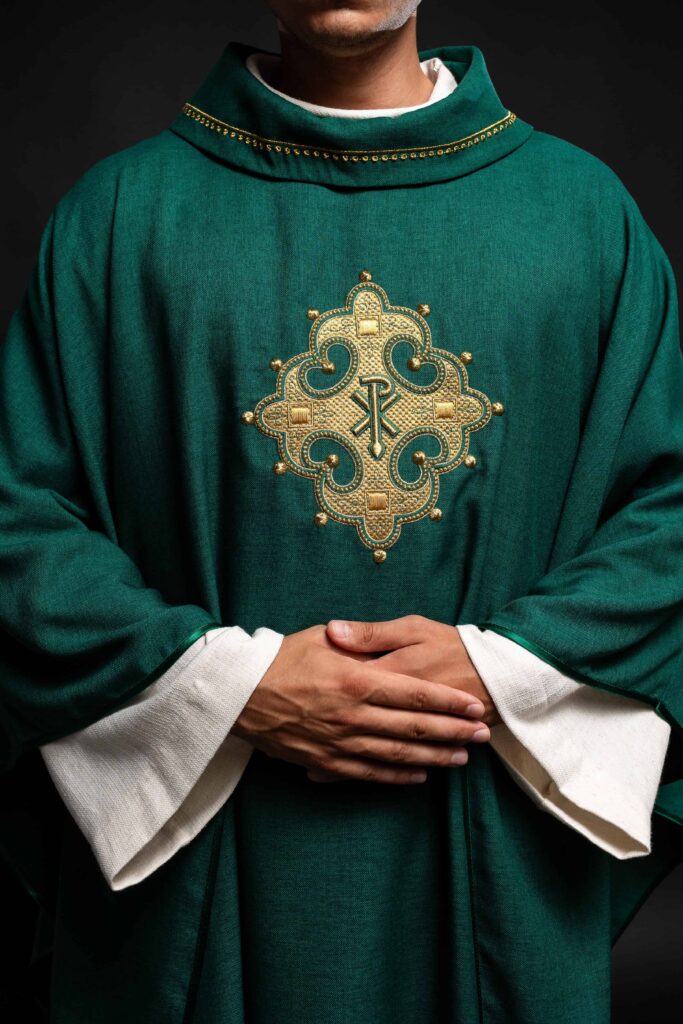The chasuble, also known as the ornat, is the main liturgical vestment worn by the priest during the celebration of Holy Mass. It is a large cloak that covers the entire body, symbolizing the charity that must envelop the priest and the divine protection that accompanies him. The chasuble is made of fine fabrics such as silk, brocade, or damask and is often richly decorated with embroidery, appliques, and sacred symbols. The color of the chasuble varies depending on the liturgical season:
- Green: Ordinary Time, symbolizing hope and eternal life.
- Violet: Advent and Lent, indicating penance, preparation, and waiting.
- White: Christmas and Easter, celebrating joy, purity, and resurrection.
- Red: Palm Sunday, Good Friday, Pentecost, and feasts of martyrs, representing blood, fire, and divine love.
- Black: Funeral Masses, symbolizing mourning and prayer for the deceased (although violet is often used today).
There are different forms of chasubles, including the Roman chasuble (wide and with folds) and the Gothic chasuble (narrower and closer to the body). The choice of form often depends on local tradition and the personal taste of the priest. You can find a variety of chasubles at HaftinaUSA.
Table of Contents
ToggleThe Alb: Symbol of Purity and Spiritual Rebirth
The alb is a white robe, long to the ankles, worn by all ministers participating in the liturgical celebration, including priests, deacons, and altar servers. Its white color symbolizes purity, innocence, and spiritual rebirth received through Baptism. The alb reminds ministers of the need to live a life consistent with the Gospel and to serve God with a pure heart. Typically, the alb is made of linen or cotton, lightweight and comfortable fabrics. It can be simple or enriched with embroidery and lace, especially along the sleeves and the bottom hem.
The alb is worn over the clerical garb (for priests and deacons) or over their own clothing (for altar servers). It is always accompanied by the cincture, a cord tied around the waist to tighten the alb and symbolize chastity and discipline. Discover our selection of Albs at HaftinaUSA.
The Stole: Distinctive Sign of the Priesthood and Diaconate
The stole is a strip of fabric, of the same color as the chasuble, worn differently by the priest and the deacon. For the priest, the stole is worn around the neck, with the ends descending parallel on the front. For the deacon, the stole is worn diagonally, from the left shoulder to the right hip, symbolizing his role as a servant. The stole is a distinctive sign of the priesthood and diaconate and represents the authority and responsibility that come from ordination. The priest wears the stole for all liturgical celebrations, including Mass, sacraments, and blessings. The deacon wears the stole during Mass, the proclamation of the Gospel, and other liturgical services.
The stole is made of the same fabric and color as the chasuble and is often decorated with embroidery and sacred symbols, such as the cross or the name of Jesus. The ends of the stole may be finished with fringes or tassels. Find the perfect stole for your ministry at HaftinaUSA.
The Cotta: Liturgical Garment for Various Functions
The cotta, also known as a surplice, is a white liturgical garment, similar to the alb but shorter, reaching to the knees or mid-thigh. It is worn over the clerical garb (or their own clothing) by priests, deacons, altar servers, and other ministers during various liturgical functions, such as the celebration of the sacraments, blessings, processions, and the recitation of the Divine Office. The cotta symbolizes the purity and dignity of the liturgical ministry. Typically, the cotta is made of linen or cotton and can be simple or enriched with lace and embroidery. There are different forms of cottas, with wide or narrow sleeves, and with different finishes along the bottom hem.
The cotta is a versatile and widely used vestment that helps create an atmosphere of solemnity and sacredness during liturgical celebrations. Explore our range of cottas at HaftinaUSA.
Other Important Liturgical Vestments and Accessories
In addition to the main vestments, there are other liturgical garments and accessories that play an important role in the celebrations:
- Amice: White cloth worn under the alb, especially when the clerical garb is not white.
- Cincture: Cord used to tighten the alb or amice around the waist.
- Humeral Veil: Large veil used to cover the hands when blessing with the Blessed Sacrament.
- Piviale (Cope): Wide and solemn cloak worn during processions and blessings.
- Mitre: Head covering worn by bishops and, in some cases, abbots.
- Pastoral Staff: Curved staff symbolizing the pastoral authority of the bishop.
The Importance of Choosing Sacred Vestments
The choice of sacred vestments is an important aspect of preparing for the liturgical celebration. The vestments must be dignified, well-maintained, and appropriate to the liturgical season and the function being celebrated. The quality of the fabrics, the beauty of the embroidery, and the attention to detail contribute to creating an atmosphere of solemnity and sacredness. Furthermore, the choice of vestments can reflect the sensitivity and personal taste of the celebrant, without ever neglecting the guidelines and traditions of the Church. HaftinaUSA offers a wide range of high-quality sacred vestments, made with care and attention to detail, to meet the needs of every liturgical celebration.
Where to Buy Quality Sacred Vestments: HaftinaUSA
If you are looking for high-quality sacred vestments, made with care and attention to detail, HaftinaUSA is the online store for you. We offer a wide range of chasubles, albs, stoles, cottas, and other liturgical accessories, made with fine fabrics and finished with exquisite embroidery and appliques. Our products are designed to meet the needs of priests, deacons, altar servers, and all those who wish to celebrate the liturgy with dignity and beauty. Visit our site and discover our collection of sacred vestments. You are sure to find the perfect vestment for every occasion.
Conclusion: Sacred Vestments as an Expression of Faith and Devotion
Sacred vestments are much more than mere garments: they are powerful symbols that express faith, devotion, and respect for the mystery being celebrated in the liturgy. Understanding the meaning and proper use of each vestment is essential to appreciate the richness and depth of the Christian tradition fully. The choice of sacred vestments is an act of love and care towards God and towards the community that gathers to pray. HaftinaUSA is proud to offer high-quality sacred vestments that help create an atmosphere of solemnity and sacredness during liturgical celebrations.











